偶然发现前文:
【转载】 PyTorch下训练数据小文件转大文件读写(附有各种存储格式对比)
在谈论pytorch的文件读取问题,因为以前是搞TensorFlow的,后来由于编写效率和生态环境问题转为了pytorch,但是同时也发现pytorch不像TensorFlow那样有专用的文件存储格式,因为官方给出的宣传是专用存储格式可以很好提高文件读取性能,那么这样说来pytorch在训练数据集的文件读取上一定不如TensorFlow使用专用格式了???
带着这个疑问搞了些研究,最后得到了意料之外的答案。
==================================================================
背景介绍:
测试的数据集选择为ImageNet2012的数据集。
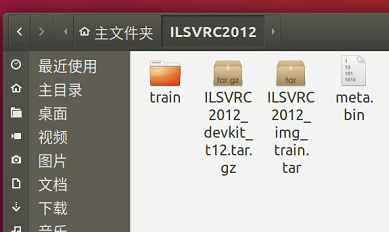
数据集大小:(压缩状态)

数据集大小:(解压状态)
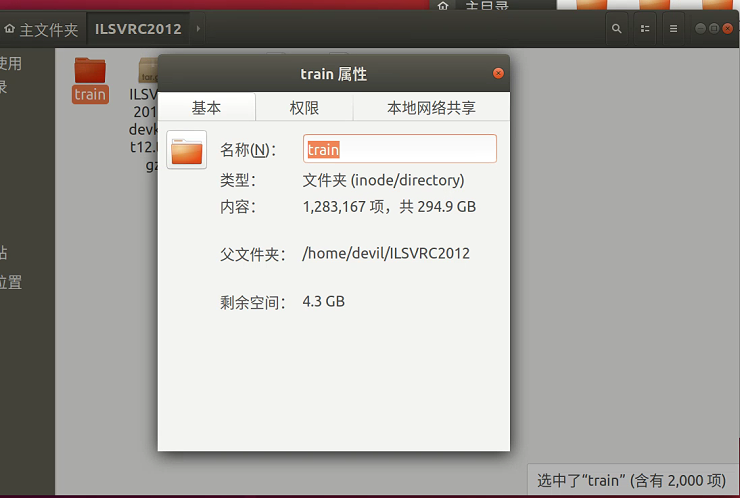
实验硬件:
A电脑:i7-8600 CPU 16G内存
B电脑:intel 自强gold 双路CPU 500G内存
==========================================
使用官方代码进行读取测试:

import argparse import multiprocessing from math import ceil import torch from torch.utils import data from torchvision import datasets, transforms class FiniteRandomSampler(data.Sampler): def __init__(self, data_source, num_samples): super().__init__(data_source) self.data_source = data_source self.num_samples = num_samples def __iter__(self): return iter(torch.randperm(len(self.data_source)).tolist()[: self.num_samples]) def __len__(self): return self.num_samples class RunningAverage: def __init__(self, num_channels=3, **meta): self.num_channels = num_channels self.avg = torch.zeros(num_channels, **meta) self.num_samples = 0 def update(self, vals): batch_size, num_channels = vals.size() if num_channels != self.num_channels: raise RuntimeError updated_num_samples = self.num_samples + batch_size correction_factor = self.num_samples / updated_num_samples updated_avg = self.avg * correction_factor updated_avg += torch.sum(vals, dim=0) / updated_num_samples self.avg = updated_avg self.num_samples = updated_num_samples def tolist(self): return self.avg.detach().cpu().tolist() def __str__(self): return "[" + ", ".join([f"{val:.3f}" for val in self.tolist()]) + "]" def make_reproducible(seed): torch.manual_seed(seed) torch.backends.cudnn.deterministic = True torch.backends.cudnn.benchmark = False def main(args): transform = transforms.Compose( [transforms.Resize(256), transforms.CenterCrop(224), transforms.ToTensor()] ) dataset = datasets.ImageNet(args.root, split="train", transform=transform) loader = data.DataLoader( dataset, shuffle=True, num_workers=args.num_workers, batch_size=args.batch_size, ) num_batches = ceil(len(dataset) / args.batch_size) with torch.no_grad(): for batch, (images, _) in enumerate(loader, 1): #if not args.quiet and batch % args.print_freq == 0: if batch%100==0: print( ( f"[{batch:6d}/{num_batches}] " ) ) def parse_input(): parser = argparse.ArgumentParser( description="Calculation of ImageNet z-score parameters" ) parser.add_argument("root", help="path to ImageNet dataset root directory") parser.add_argument( "--num-samples", metavar="N", type=int, default=None, help="Number of images used in the calculation. Defaults to the complete dataset.", ) parser.add_argument( "--num-workers", metavar="N", type=int, default=None, help="Number of workers for the image loading. Defaults to the number of CPUs.", ) parser.add_argument( "--batch-size", metavar="N", type=int, default=None, help="Number of images processed in parallel. Defaults to the number of workers", ) parser.add_argument( "--device", metavar="DEV", type=str, default=None, help="Device to use for processing. Defaults to CUDA if available.", ) parser.add_argument( "--seed", metavar="S", type=int, default=None, help="If given, runs the calculation in deterministic mode with manual seed S.", ) parser.add_argument( "--print_freq", metavar="F", type=int, default=50, help="Frequency with which the intermediate results are printed. Defaults to 50.", ) parser.add_argument( "--quiet", action="store_true", help="If given, only the final results is printed", ) args = parser.parse_args() if args.num_workers is None: args.num_workers = multiprocessing.cpu_count() if args.batch_size is None: args.batch_size = args.num_workers if args.device is None: device = "cuda" if torch.cuda.is_available() else "cpu" args.device = torch.device(device) return args if __name__ == "__main__": args = parse_input() main(args)
保存为y.py
命令:
python y.py .
其中 . 指 ILSVRC2012_img_train.tar 所在目录。
===========================
B服务器首次执行:


B服务器非首次执行:

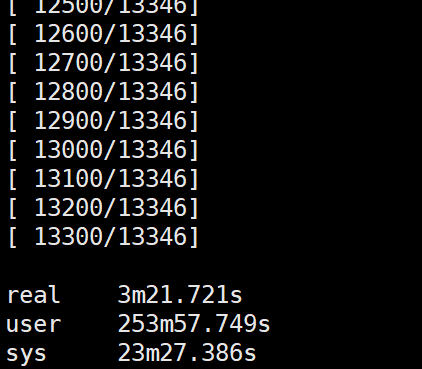

由于B服务器内存很大,足够将所有数据全部存入到内存中,首次执行是将所有图片从硬盘读到内存中,其中应用程序内存空间不对这些图片进行保存,而系统内核对这些图片进行缓存,首次执行后所有图片数据全部保存在内核的缓存数据中,所以非首次执行可以极大的加快读取速度,因为此时的数据不是从硬盘中读取而是从内存的缓存空间中读取。
===================================
使用A电脑首次执行:

使用A电脑非首次执行:

可以看到A电脑不论是不是首次执行需要的时间都大致相同,且时间较长。
原因:
A电脑内存空间较小,所以图片无法全部装入到内存的缓存空间中,所以执行图片读取操作时会频繁的进行页面置换,换句话说A电脑执行读取操作基本上可以认为是每次读取都是从硬盘空间导入的,而且A电脑仅有的内存空间也会被缓存消耗掉,但是消耗的内存中的缓存并不能满足图片读取的需求,从而导致图片读取引起内存缺页,从硬盘中读取图片,而内存中仅有的空间还被缓存暂具,从而加重系统的竞争。
=================================================================
那么大内存的电脑除了首次读取图片需要从硬盘加载其他都是直接从内存读取,这样的话其实是否使用专用的数据文件格式并不会有太大的性能影响。那么对于内存的电脑来说是不是专用的数据文件格式会提高性能呢?
为此,编写下面代码,实现小图片的大文件整合,将小图片写入二进制文件中:

from PIL import Image import numpy as np from typing import Any, Callable, cast, Dict, List, Optional, Tuple import os import pickle IMG_EXTENSIONS = ('.jpg', '.jpeg', '.png', '.ppm', '.bmp', '.pgm', '.tif', '.tiff', '.webp') def has_file_allowed_extension(filename: str, extensions: Tuple[str, ...]) -> bool: """Checks if a file is an allowed extension. Args: filename (string): path to a file extensions (tuple of strings): extensions to consider (lowercase) Returns: bool: True if the filename ends with one of given extensions """ return filename.lower().endswith(extensions) def is_image_file(filename: str) -> bool: """Checks if a file is an allowed image extension. Args: filename (string): path to a file Returns: bool: True if the filename ends with a known image extension """ return has_file_allowed_extension(filename, IMG_EXTENSIONS) def find_classes(directory: str) -> Tuple[List[str], Dict[str, int]]: """Finds the class folders in a dataset. See :class:`DatasetFolder` for details. """ classes = sorted(entry.name for entry in os.scandir(directory) if entry.is_dir()) if not classes: raise FileNotFoundError(f"Couldn't find any class folder in {directory}.") class_to_idx = {cls_name: i for i, cls_name in enumerate(classes)} return classes, class_to_idx def get_path_classIdx(directory, class_to_idx): instances = [] available_classes = set() for target_class in sorted(class_to_idx.keys()): class_index = class_to_idx[target_class] target_dir = os.path.join(directory, target_class) if not os.path.isdir(target_dir): continue for root, _, fnames in sorted(os.walk(target_dir, followlinks=True)): for fname in sorted(fnames): if is_image_file(fname): path = os.path.join(root, fname) item = path, class_index instances.append(item) if target_class not in available_classes: available_classes.add(target_class) empty_classes = set(class_to_idx.keys()) - available_classes if empty_classes: msg = f"Found no valid file for the classes {', '.join(sorted(empty_classes))}. " raise FileNotFoundError(msg) return instances def pil_loader(path: str) -> Image.Image: # open path as file to avoid ResourceWarning (https://github.com/python-pillow/Pillow/issues/835) with open(path, 'rb') as f: img = Image.open(f) return img.convert('RGB') def png_loader(path: str): # open path as file to avoid ResourceWarning (https://github.com/python-pillow/Pillow/issues/835) with open(path, 'rb') as f: return f.read() ########################################################### directory = "/home/devil/ILSVRC2012/train" data_file_path = "/media/devil/数据/data.dat" target_file_path = "/media/devil/数据/target.dat" def train_data_pickle(instances, data_file, target_file): # instances = instances[:10000] loc = 0 infos = [] L = len(instances) for i, (path, target_idx) in enumerate(instances, 1): img = np.array(pil_loader(path)) # print(img.dtype, img.shape, target_idx) a, b, c = img.shape data_file.write(img.flatten()) infos.append((a,b,c,loc,target_idx)) loc += a*b*c if i%1000 == 0: print("{} / {}".format(i, L)) pickle.dump(infos, target_file) def train_data_pickle_png(instances, data_file, target_file): loc = 0 infos = [] L = len(instances) for i, (path, target_idx) in enumerate(instances, 1): img = png_loader(path) # img = np.array(pil_loader(path)) # print(img.dtype, img.shape, target_idx) # a, b, c = img.shape # data_file.write(img.flatten()) # infos.append((a,b,c,loc,target_idx)) img_size = data_file.write(img) infos.append((loc, img_size, target_idx)) loc += img_size if i%1000 == 0: print("{} / {}".format(i, L)) pickle.dump(infos, target_file) def main(): classes, class_to_idx = find_classes(directory) if not class_to_idx: raise ValueError("'class_to_index' must have at least one entry to collect any samples.") instances = get_path_classIdx(directory, class_to_idx) data_file = open(data_file_path, 'wb') target_file = open(target_file_path, 'wb') # train_data_pickle(instances, data_file, target_file) train_data_pickle_png(instances, data_file, target_file) data_file.close() target_file.close() if __name__ == "__main__": main()
验证写入的二进制文件是否正常,读取的数据与小文件中读取的数据是否相同:
from PIL import Image import numpy as np from typing import Any, Callable, cast, Dict, List, Optional, Tuple import os import pickle from io import BytesIO ########################################################### directory = "/home/devil/ILSVRC2012/train" data_file_path = "/media/devil/数据/data.dat" target_file_path = "/media/devil/数据/target.dat" root = "/home/devil/ILSVRC2012" def main(): data_file = open(data_file_path, 'rb') target_file = open(target_file_path, 'rb') infos = pickle.load(target_file) def get_img_target(indexId): a,b,c,loc,target_idx = infos[indexId] data_file.seek(loc) img = np.frombuffer(data_file.read(a*b*c), np.uint8).reshape(a,b,c) return img, target_idx def get_png_target(indexId): loc, png_size, target_idx = infos[indexId] data_file.seek(loc) img = data_file.read(png_size) return img, target_idx from torchvision import datasets dataset = datasets.ImageNet(root, split="train") false_count_img = 0 false_count_target = 0 for i in range(len(dataset)): true_img, true_target = dataset[i] true_img = np.array(true_img) true_target = int(true_target) # false_img, false_target = get_img_target(i) false_img, false_target = get_png_target(i) false_img = Image.open(BytesIO(false_img)) # false_img = np.asarray(false_img, np.uint8) if not np.all(true_img==false_img): false_count_img += 1 if not (true_target==false_target): false_count_target += 1 if i%9999 == 1: print("{} / {}".format(i, len(dataset)), false_count_img, false_count_target) if __name__ == "__main__": main()
数据的读取测试代码:
为图方便直接修改库代码:
修改文件:
~anaconda3/envs/test/lib/python3.7/site-packages/torchvision/datasets/folder.py
修改后的整体文件代码:

from .vision import VisionDataset from PIL import Image from io import BytesIO import pickle import numpy as np import cv2 import os import os.path from typing import Any, Callable, cast, Dict, List, Optional, Tuple def has_file_allowed_extension(filename: str, extensions: Tuple[str, ...]) -> bool: """Checks if a file is an allowed extension. Args: filename (string): path to a file extensions (tuple of strings): extensions to consider (lowercase) Returns: bool: True if the filename ends with one of given extensions """ return filename.lower().endswith(extensions) def is_image_file(filename: str) -> bool: """Checks if a file is an allowed image extension. Args: filename (string): path to a file Returns: bool: True if the filename ends with a known image extension """ return has_file_allowed_extension(filename, IMG_EXTENSIONS) def find_classes(directory: str) -> Tuple[List[str], Dict[str, int]]: """Finds the class folders in a dataset. See :class:`DatasetFolder` for details. """ classes = sorted(entry.name for entry in os.scandir(directory) if entry.is_dir()) if not classes: raise FileNotFoundError(f"Couldn't find any class folder in {directory}.") class_to_idx = {cls_name: i for i, cls_name in enumerate(classes)} return classes, class_to_idx def make_dataset( directory: str, class_to_idx: Optional[Dict[str, int]] = None, extensions: Optional[Tuple[str, ...]] = None, is_valid_file: Optional[Callable[[str], bool]] = None, ) -> List[Tuple[str, int]]: """Generates a list of samples of a form (path_to_sample, class). See :class:`DatasetFolder` for details. Note: The class_to_idx parameter is here optional and will use the logic of the ``find_classes`` function by default. """ directory = os.path.expanduser(directory) if class_to_idx is None: _, class_to_idx = find_classes(directory) elif not class_to_idx: raise ValueError("'class_to_index' must have at least one entry to collect any samples.") both_none = extensions is None and is_valid_file is None both_something = extensions is not None and is_valid_file is not None if both_none or both_something: raise ValueError("Both extensions and is_valid_file cannot be None or not None at the same time") if extensions is not None: def is_valid_file(x: str) -> bool: return has_file_allowed_extension(x, cast(Tuple[str, ...], extensions)) is_valid_file = cast(Callable[[str], bool], is_valid_file) instances = [] available_classes = set() for target_class in sorted(class_to_idx.keys()): class_index = class_to_idx[target_class] target_dir = os.path.join(directory, target_class) if not os.path.isdir(target_dir): continue for root, _, fnames in sorted(os.walk(target_dir, followlinks=True)): for fname in sorted(fnames): if is_valid_file(fname): path = os.path.join(root, fname) item = path, class_index instances.append(item) if target_class not in available_classes: available_classes.add(target_class) empty_classes = set(class_to_idx.keys()) - available_classes if empty_classes: msg = f"Found no valid file for the classes {', '.join(sorted(empty_classes))}. " if extensions is not None: msg += f"Supported extensions are: {', '.join(extensions)}" raise FileNotFoundError(msg) return instances class DatasetFolder(VisionDataset): """A generic data loader. This default directory structure can be customized by overriding the :meth:`find_classes` method. Args: root (string): Root directory path. loader (callable): A function to load a sample given its path. extensions (tuple[string]): A list of allowed extensions. both extensions and is_valid_file should not be passed. transform (callable, optional): A function/transform that takes in a sample and returns a transformed version. E.g, ``transforms.RandomCrop`` for images. target_transform (callable, optional): A function/transform that takes in the target and transforms it. is_valid_file (callable, optional): A function that takes path of a file and check if the file is a valid file (used to check of corrupt files) both extensions and is_valid_file should not be passed. Attributes: classes (list): List of the class names sorted alphabetically. class_to_idx (dict): Dict with items (class_name, class_index). samples (list): List of (sample path, class_index) tuples targets (list): The class_index value for each image in the dataset """ def __init__( self, root: str, loader: Callable[[str], Any], extensions: Optional[Tuple[str, ...]] = None, transform: Optional[Callable] = None, target_transform: Optional[Callable] = None, is_valid_file: Optional[Callable[[str], bool]] = None, ) -> None: super(DatasetFolder, self).__init__(root, transform=transform, target_transform=target_transform) classes, class_to_idx = self.find_classes(self.root) samples = self.make_dataset(self.root, class_to_idx, extensions, is_valid_file) self.loader = loader self.extensions = extensions self.classes = classes self.class_to_idx = class_to_idx self.samples = samples self.targets = [s[1] for s in samples] self.data_file_path = "/media/devil/数据/data.dat" self.target_file_path = "/media/devil/数据/target.dat" # self.data_file = open(self.data_file_path, 'rb') self.target_file = open(self.target_file_path, 'rb') self.infos = pickle.load(self.target_file) @staticmethod def make_dataset( directory: str, class_to_idx: Dict[str, int], extensions: Optional[Tuple[str, ...]] = None, is_valid_file: Optional[Callable[[str], bool]] = None, ) -> List[Tuple[str, int]]: """Generates a list of samples of a form (path_to_sample, class). This can be overridden to e.g. read files from a compressed zip file instead of from the disk. Args: directory (str): root dataset directory, corresponding to ``self.root``. class_to_idx (Dict[str, int]): Dictionary mapping class name to class index. extensions (optional): A list of allowed extensions. Either extensions or is_valid_file should be passed. Defaults to None. is_valid_file (optional): A function that takes path of a file and checks if the file is a valid file (used to check of corrupt files) both extensions and is_valid_file should not be passed. Defaults to None. Raises: ValueError: In case ``class_to_idx`` is empty. ValueError: In case ``extensions`` and ``is_valid_file`` are None or both are not None. FileNotFoundError: In case no valid file was found for any class. Returns: List[Tuple[str, int]]: samples of a form (path_to_sample, class) """ if class_to_idx is None: # prevent potential bug since make_dataset() would use the class_to_idx logic of the # find_classes() function, instead of using that of the find_classes() method, which # is potentially overridden and thus could have a different logic. raise ValueError( "The class_to_idx parameter cannot be None." ) return make_dataset(directory, class_to_idx, extensions=extensions, is_valid_file=is_valid_file) def find_classes(self, directory: str) -> Tuple[List[str], Dict[str, int]]: """Find the class folders in a dataset structured as follows:: directory/ ├── class_x │ ├── xxx.ext │ ├── xxy.ext │ └── ... │ └── xxz.ext └── class_y ├── 123.ext ├── nsdf3.ext └── ... └── asd932_.ext This method can be overridden to only consider a subset of classes, or to adapt to a different dataset directory structure. Args: directory(str): Root directory path, corresponding to ``self.root`` Raises: FileNotFoundError: If ``dir`` has no class folders. Returns: (Tuple[List[str], Dict[str, int]]): List of all classes and dictionary mapping each class to an index. """ return find_classes(directory) def __getitem__(self, index: int) -> Tuple[Any, Any]: """ Args: index (int): Index Returns: tuple: (sample, target) where target is class_index of the target class. """ # path, target = self.samples[index] loc, png_size, target_idx = self.infos[index] # print(loc, png_size, target_idx) data_file = open(self.data_file_path, 'rb') data_file.seek(loc) img = data_file.read(png_size) data_file.close() # print(img) # img = np.asarray(Image.open(BytesIO(img)), np.uint8) img = Image.open(BytesIO(img)).convert('RGB') # f_array_bytes = np.frombuffer(img, np.uint8) # img = cv2.cvtColor(cv2.imdecode(f_array_bytes, cv2.IMREAD_COLOR), cv2.COLOR_BGR2RGB) if self.transform is not None: img = self.transform(img) if self.target_transform is not None: target_idx = self.target_transform(target_idx) return img, target_idx """ sample = self.loader(path) if self.transform is not None: sample = self.transform(sample) if self.target_transform is not None: target = self.target_transform(target) return sample, target """ def __len__(self) -> int: # return len(self.samples) return len(self.infos) IMG_EXTENSIONS = ('.jpg', '.jpeg', '.png', '.ppm', '.bmp', '.pgm', '.tif', '.tiff', '.webp') def pil_loader(path: str) -> Image.Image: # open path as file to avoid ResourceWarning (https://github.com/python-pillow/Pillow/issues/835) with open(path, 'rb') as f: img = Image.open(f) return img.convert('RGB') # TODO: specify the return type def accimage_loader(path: str) -> Any: import accimage try: return accimage.Image(path) except IOError: # Potentially a decoding problem, fall back to PIL.Image return pil_loader(path) def default_loader(path: str) -> Any: from torchvision import get_image_backend if get_image_backend() == 'accimage': return accimage_loader(path) else: return pil_loader(path) class ImageFolder(DatasetFolder): """A generic data loader where the images are arranged in this way by default: :: root/dog/xxx.png root/dog/xxy.png root/dog/[...]/xxz.png root/cat/123.png root/cat/nsdf3.png root/cat/[...]/asd932_.png This class inherits from :class:`~torchvision.datasets.DatasetFolder` so the same methods can be overridden to customize the dataset. Args: root (string): Root directory path. transform (callable, optional): A function/transform that takes in an PIL image and returns a transformed version. E.g, ``transforms.RandomCrop`` target_transform (callable, optional): A function/transform that takes in the target and transforms it. loader (callable, optional): A function to load an image given its path. is_valid_file (callable, optional): A function that takes path of an Image file and check if the file is a valid file (used to check of corrupt files) Attributes: classes (list): List of the class names sorted alphabetically. class_to_idx (dict): Dict with items (class_name, class_index). imgs (list): List of (image path, class_index) tuples """ def __init__( self, root: str, transform: Optional[Callable] = None, target_transform: Optional[Callable] = None, loader: Callable[[str], Any] = default_loader, is_valid_file: Optional[Callable[[str], bool]] = None, ): super(ImageFolder, self).__init__(root, loader, IMG_EXTENSIONS if is_valid_file is None else None, transform=transform, target_transform=target_transform, is_valid_file=is_valid_file) self.imgs = self.samples
数据读取代码与之前相同:

import argparse import multiprocessing from math import ceil import torch from torch.utils import data from torchvision import datasets, transforms class FiniteRandomSampler(data.Sampler): def __init__(self, data_source, num_samples): super().__init__(data_source) self.data_source = data_source self.num_samples = num_samples def __iter__(self): return iter(torch.randperm(len(self.data_source)).tolist()[: self.num_samples]) def __len__(self): return self.num_samples class RunningAverage: def __init__(self, num_channels=3, **meta): self.num_channels = num_channels self.avg = torch.zeros(num_channels, **meta) self.num_samples = 0 def update(self, vals): batch_size, num_channels = vals.size() if num_channels != self.num_channels: raise RuntimeError updated_num_samples = self.num_samples + batch_size correction_factor = self.num_samples / updated_num_samples updated_avg = self.avg * correction_factor updated_avg += torch.sum(vals, dim=0) / updated_num_samples self.avg = updated_avg self.num_samples = updated_num_samples def tolist(self): return self.avg.detach().cpu().tolist() def __str__(self): return "[" + ", ".join([f"{val:.3f}" for val in self.tolist()]) + "]" def make_reproducible(seed): torch.manual_seed(seed) torch.backends.cudnn.deterministic = True torch.backends.cudnn.benchmark = False def main(args): transform = transforms.Compose( [transforms.Resize(256), transforms.CenterCrop(224), transforms.ToTensor()] ) dataset = datasets.ImageNet(args.root, split="train", transform=transform) loader = data.DataLoader( dataset, shuffle=True, num_workers=args.num_workers, batch_size=args.batch_size, ) num_batches = ceil(len(dataset) / args.batch_size) with torch.no_grad(): for batch, (images, _) in enumerate(loader, 1): #if not args.quiet and batch % args.print_freq == 0: if batch%100==0: print( ( f"[{batch:6d}/{num_batches}] " ) ) def parse_input(): parser = argparse.ArgumentParser( description="Calculation of ImageNet z-score parameters" ) parser.add_argument("root", help="path to ImageNet dataset root directory") parser.add_argument( "--num-samples", metavar="N", type=int, default=None, help="Number of images used in the calculation. Defaults to the complete dataset.", ) parser.add_argument( "--num-workers", metavar="N", type=int, default=None, help="Number of workers for the image loading. Defaults to the number of CPUs.", ) parser.add_argument( "--batch-size", metavar="N", type=int, default=None, help="Number of images processed in parallel. Defaults to the number of workers", ) parser.add_argument( "--device", metavar="DEV", type=str, default=None, help="Device to use for processing. Defaults to CUDA if available.", ) parser.add_argument( "--seed", metavar="S", type=int, default=None, help="If given, runs the calculation in deterministic mode with manual seed S.", ) parser.add_argument( "--print_freq", metavar="F", type=int, default=50, help="Frequency with which the intermediate results are printed. Defaults to 50.", ) parser.add_argument( "--quiet", action="store_true", help="If given, only the final results is printed", ) args = parser.parse_args() if args.num_workers is None: args.num_workers = multiprocessing.cpu_count() if args.batch_size is None: args.batch_size = args.num_workers if args.device is None: device = "cuda" if torch.cuda.is_available() else "cpu" args.device = torch.device(device) return args if __name__ == "__main__": args = parse_input() main(args)
执行: python y.py +数据文件目录
执行性能:大约5小时

由于时间原因没有全部跑完,不过可以知道其运行时间不会好于从小文件中读取的性能。
=========================================================
总结:
在文件读取操作中,大文件性能和小文件性能只有在首次读取时候会有性能区别,如果电脑内存主机足够大的话首次从大文件读取数据要比小文件中读取性能要好一些,不过这也只是在首次读取过程中,而且应该不会有太明显差别,因为即使是大数据我们读取的时候也是随机读取(shuffle模式)。如果主机内存不够的话需要频繁的读取硬盘的话首次读取和非首次读取性能基本一致。
总的来说,在训练神经网络模型时影响文件读取速度并不是文件的存储格式,大文件和小文件并不会明显的提高读取性能,基本上可以认为是一致的,即使是大内存主机首次读取时也不会有显著差距。而真正影响训练集数据的读取速度的真正的关键因素其实是内存大小。
个人分析专用数据文件格式最大的好处是节省硬盘空间,如文中图片显示压缩数据包大约为147.9G左右大小,解压后占294.9G左右大小,而使用专用数据文件格式(单个大文件),占硬盘空间不会比压缩数据包差别太多,个人计算后发现其大小反而有了略微下降:

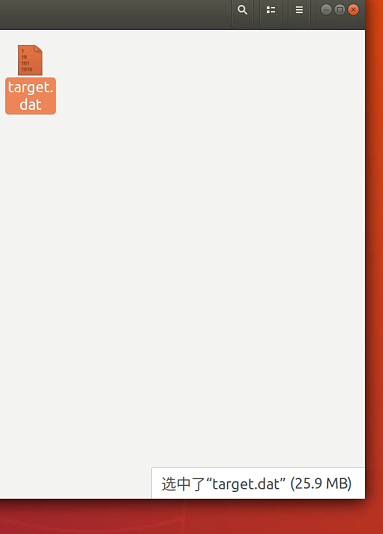
后话:
有时候不能只听宣传,真实的上手搞一搞就知道到底哪个是对的了。
pytorch没有专用数据文件格式除了占硬盘空间外一点也不影响读取性能,综合考虑pytorch不使用专用数据文件格式完全OK 。官方给出的小文件读取方式完全OK 。
------------------------------------------------------------------------
补充:
A电脑在读取大文件的实验中最后性能:
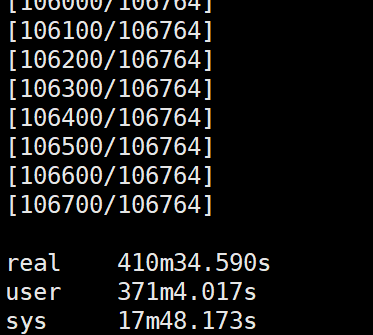
可以看到在A电脑中最后的大文件读取性能不如小文件的读取性能,个人推测原因是同样内存中无法进行缓存的情况下大文件的打开更加的耗费时间,同样频繁的打开文件小文件更加有优势,在A电脑中内存空间太小导致磁盘寻址的读取性能并不会对实验最后结果有太大影响,主要因素还是电脑无法有效缓存数据。
----------------------------------------------------------------------------
